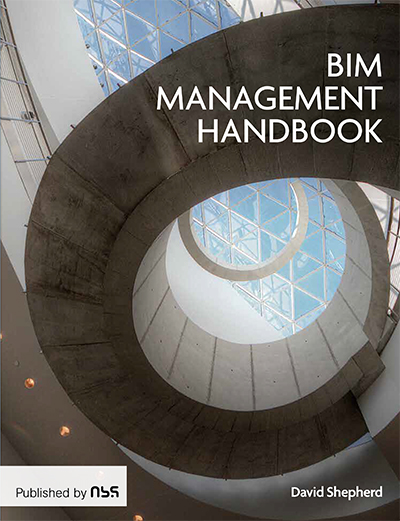
For a committed level 2 BIM supporter, as I am, the book is at times a little like a conversation with someone holding the same political views. But in the wider context of Level 2 BIM, there are different types of need.– Robert Klaschka
In his second book review for BIM+, Robert Klaschka, director of digital built environment for Sumo Services, appreciates the BIM Management Handbook by David Shepherd, but says that more BIM realism would have helped.
David Shepherd’s BIM Management Handbook sets out with ambitious goals to define the issues around this new process. There is no question that this book fills a gap that has been wanting for some time, and fills it comprehensively.
The book provides a practical road map for those implementing and managing BIM workflows, spanning both organisational strategy and day-to-day practical tasks. According to the publisher, NBS, it’s aimed at BIM coordinators and managers, architectural principals, design team leaders and architectural technicians.
Personally, I am a firm believer that the BIM Task Group’s approach, as documented in the PAS 1192 suite and associated supporting documents, is the right and best way to achieve true collaborative BIM-enabled projects. So I was particularly satisfied to see the author’s discipline in remaining focused on the UK process instead of mixing in bits of other standards from other countries to bridge over their failure to research our own ones properly.
The book is at its best when the author is in his comfort zone, with clear discussion of matters focused around clients’ needs and interactions between consultants and Tier 1 contractors.
But it doesn’t provide the same comprehensive guidance for parties further down the food chain – which reflects a more general theme in an industry which does not yet provide the much-needed support or understanding of Level 2 BIM to suppliers and manufacturers.
For a committed level 2 BIM supporter, as I am, the book is at times a little like a conversation with someone holding the same political views. But in the wider context of Level 2 BIM, there are different types of need.
For the beginner, for instance, there is a need for a comprehensive plain-speaking text that leads the reader into BIM while giving a realistic picture of what can be expected. This book doesn’t cater for this type of reader on its own. For example, the assumption that your client will have a good understanding of their own strategy, which seems to be a given in the book, is very rarely encountered.
The picture painted here of a world where things operate in just the way the standards prescribe is not the case, as we all know.
Alternatively, for those individuals like me, who have achieved the small victory of learning and understanding all of the processes and acronyms that the PAS 1192 documents throws at you, the book is not a bad reference. Where it falls down is in the explanation of what these standards mean.

This is typified by the chapter on the legal and contractual matters surrounding BIM. Written by Dr David Mosey, director of the Centre of Construction Law at King’s College London, it is one of the best explanations I have read of the legal consequences of the CIC BIM Protocol, but it falls down because, first, I don’t believe the author is familiar with the purpose the protocol was designed to achieve, and second because it fails to explain what these consequences actually mean in practice.
Take, for example, the fact that the clauses covering fair use of models are a fundamental necessity in facilitating collaborative working. Or that the reason model exchange is covered by a lower level of duty of care is because the model is to facilitate the design and construction process not to be handed over as a client deliverable.
I’d have liked to have seen this chapter as more of a joint effort, with Mosey giving his legal analysis and Shepherd discussing what this enabled in the real world.
Perhaps this is something for the second edition, because with a little more grounding in the reality of Level 2 BIM management, the highs and lows, I think the book would promote itself above being a useful reference on BIM champions shelf.
The BIM Management Handbook, £40, is published by NBS and available from the RIBA bookshop
More from Robert Klaschka
Comments
Comments are closed.














Which other book would be more adequate for someone looking for guidance about “the wider context of Level 2 BIM”?
Teodor,
I’m reluctant to respond in detail to the issues raised here by Robert (they say, ‘self-praise is no praise at all’) and some concerns are entirely valid. No book on BIM is all things to all construction people.
I would state that the book does address the ‘wider context of Level 2 BIM’. The book doesn’t assume that everything will go swimmingly well, but identifies key pitfalls, such as poor leadership and the lack of strategic priorities and clear objectives.
The text does not assume that all construction clients must have a BIM strategy, but that it is possible to discern their goals for asset management.
There are also plain language explanations of BIM jargon for those new to the technology. That said, my book is neither a software manual, nor an edited digest of case studies.